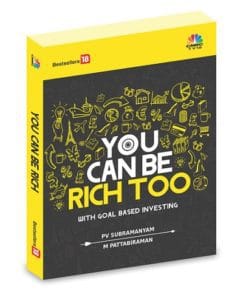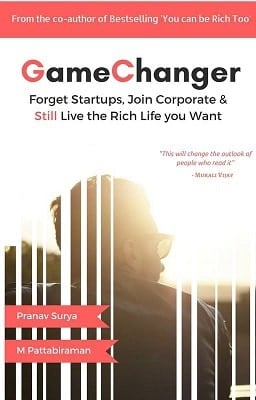Ever wonder why index investing or passive investing should work? In this article, SEBI registered fee-only advisor Swapnil Kendhe explains the basics of indexing and why it is effective.
About the author: Swapnil is a SEBI Registered Investment Advisor and part of my fee-only financial planners’ list. You can learn more about him and his service via his website, Vivektaru.
Don’t look for the needle – buy the haystack. John C. Bogle
In its purest form, an index fund buys all the securities in a market in proportions equal to their relative values. Equivalently, it holds x percentage of outstanding shares (or certificates) of every security in the market. – William Sharpe.
To index the Indian stock market perfectly, you must buy a fixed percentage of every listed company’s outstanding stock in India. If you hold 0.00001% of the outstanding stocks of HDFC Bank, you must also hold 0.00001% of the outstanding stocks of Reliance and that of every other listed company in India. You would then have a perfect Indian stock market index portfolio or the market portfolio. When an investor holds the same percentage of all available securities’ outstanding shares, he “holds a market portfolio”.
Since stocks owned by promoters and strategic investors are not readily available in the secondary market, all index funds and ETFs are free-float market capitalisation based. They hold a fixed percentage of free-float shares/free-float market capitalisation of all listed companies in a market or segment of a market.
Each stock’s weightage in an index fund is different because the free-float market capitalisation of each stock in the index is different. If the market value of the free-float of HDFC Bank is higher than that of IndusInd Bank, the weightage of HDFC Bank stock in the Index fund will be higher than that of IndusInd Bank. However, the index fund holds the same percentage of the free-float market capitalisation of both Banks.
Join 32,000+ readers and get free money management solutions delivered to your inbox! Subscribe to get posts via email! (Link takes you to our email sign-up form)
🔥Want to create a complete financial plan? Learn goal-based investing? Exclusive access to our DIY tools? Increase your income with your skills? Use this link to enjoy massive discounts on our robo-advisory tool & courses! 🔥
Index funds like Nifty Index Fund and Nifty 100 Index Fund attempt to index a portion of the market. These index funds don’t perfectly index the Indian stock market. A low-cost Nifty 500 Index Fund would be better for an index investor since it captures a bigger portion of the listed Indian equity market.
If we get an ultra-low-cost Nifty 500 Index Fund and all the active investors pick stocks from Nifty 500 companies, then before costs, the return on the average actively managed rupee will equal the return of the Nifty 500 index fund. Why?
For easier understanding, let us assume that ‘A’ and ‘B’ are the only two listed companies on a stock exchange. There are 150 stocks of ‘A’ and 100 stocks of ‘B’. The initial price of both ‘A’ and ‘B’ is 1000. After a few months, the price of ‘A’ increases to 1200 & the price of ‘B’ increases to 1300.
| Stock Name | A | B |
| No. of stocks | 150 | 100 |
| Initial Price | 1000 | 1000 |
| Final Price | 1200 | 1300 |
| Return | 20.00% | 30.00% |
Suppose there are only 3 investors in the market who are collectively holding both these stocks. One of these 3 investors is a passive investor who believes in indexing, while the other 2 are active investors. Let’s say their names are ‘Passive’, ‘Active1’ and ‘Active2’.
Since ‘Passive’ believes in indexing, he holds the same percentage of outstanding stocks/the same percentage of the market value of both ‘A’ and ‘B’. Suppose ‘Passive’ holds 10% of outstanding stocks of ‘A’ and ‘B,’ i.e. 15 stocks of ‘A’ (10% of 150) and 10 stocks of ‘B’ (10% of 100).

The balance stocks of ‘A’ and ‘B’ shall be held collectively by ‘Active1’ & ‘Active2’.

Notice that the collective return of ‘Active1’ and ‘Active2’ is the same as that of the return of ‘Passive’. This happened because, just like ‘Passive’ is holding the same percentage of outstanding stocks of ‘A’ and ‘B’ (10%), ‘Active1’ and ‘Active2’ are also collectively holding the same percentage of outstanding stocks of A and B (90%).
If you hold the same percentage of all listed companies’ outstanding stocks, the weightage of each stock in your portfolio is the same whether you hold 0.00001% of outstanding shares of all companies, 10% or 90%.
Since the collective return of ‘Active1’ and ‘Active2’ is the same as that of ‘Passive’, if one of the two active investors’ portfolio generates a higher return than ‘Passive’, the other active investor’s portfolio must underperform ‘Passive’.
Between stocks ‘A’ and ‘B’, stock ‘B’ has generated a higher return than stock ‘A’. If ‘Active 1’ is to outperform ‘Passive’, he must have a higher weightage of ‘B’ in his portfolio than the weightage of ‘B’ in Passive’s portfolio.
Suppose ‘Active1’ holds 70 stocks of ‘B’ and 75 stocks of ‘A’. The initial weightage of ‘B’ in Active1’s portfolio will be 48%. Remember, the weightage of ‘B’ in Passive’s portfolio is 40%. With this allocation, ‘Active1’ would outperform ‘Passive’.

But this would leave Active2’s portfolio with 60 stocks of ‘A’ (‘Passive’ & ‘Active1’ are holding 15+75, i.e. 90 stocks of ‘A’) & 20 stocks of ‘B’ (‘Passive’ and ‘Active1’ are holding 10+70, i.e. 80 stocks of ‘A’.) So Active2’s portfolio would have a lower weightage of ‘B’ than the weightage of ‘B’ in Passive’s portfolio. Therefore ‘Active2’ would underperform ‘Passive’.

No matter what ‘Active1’ and ‘Active2’ do individually if one of them holds a higher weightage of higher return generating stock in his portfolio than the weightage of that stock in Passive’s portfolio, the other must hold a lower weightage of that stock in his portfolio. Therefore, if one of two active investors is to outperform ‘Passive’, the other must underperform.
The same arithmetic is in play in listed equity markets. The index investor’s portfolio weights are exactly the same as active investors’ aggregate portfolio weights if active investors select stocks from the same universe from which we construct the index portfolio. Therefore, before costs, the return on the average actively managed rupee is always the same as the return on the average passively managed rupee.
But there are costs involved in investing, and active management costs significantly more than passive management. Therefore, post cost, the return on the average actively managed rupee will always be less than the return on the average passively managed rupee.
At times, it is possible for actively managed large cap funds in aggregate to outperform Nifty 100 TRI or actively managed midcap funds in aggregate to outperform Nifty Midcap 150 TRI. There are two reasons for it.
1) There are other active investors in the market, along with mutual fund managers.
2) Nifty 100 TRI and Nifty Midcap 150 TRI are inexact benchmarks of actively managed largecap and midcap funds. Actively managed large cap funds can invest up to 20% of the portfolio outside Nifty 100 companies, while actively managed midcap funds can invest up to 35% outside Nifty Midcap 150 companies.
You can always find funds that have beaten the index in the past, but there is no certainty that these funds will continue to beat the index. We cannot predict the future performance of actively managed funds. There is human behaviour involved in fund management. Human behaviour is inconsistent and therefore unpredictable. There is no science in identifying winning funds of the future in advance. The whole exercise is chance driven.
Typically, investors invest in an actively managed fund that has beaten the index and its peers in the recent past. They keep the fund until it underperforms and then search for another hot fund. This activity generates intellectual stimulation but results in underperformance over the long term.
It is a mathematical fact that indexing works. If you are a retail investor who lacks the knowledge and time required to do successful active investing, there is no better strategy than indexing. Active investors believe they can beat the market, but the cold fact is that most can’t, and most won’t. Index investors get a better return than most active investors.

Use our Robo-advisory Tool to create a complete financial plan! ⇐More than 3,000 investors and advisors use this! Use the discount code: robo25 for a 20% discount. Plan your retirement (early, normal, before, and after), as well as non-recurring financial goals (such as child education) and recurring financial goals (like holidays and appliance purchases). The tool would help anyone aged 18 to 80 plan for their retirement, as well as six other non-recurring financial goals and four recurring financial goals, with a detailed cash flow summary.
🔥You can also avail massive discounts on our courses and the freefincal investor circle! 🔥& join our community of 8000+ users!
Track your mutual funds and stock investments with this Google Sheet!
We also publish monthly equity mutual funds, debt and hybrid mutual funds, index funds, and ETF screeners, as well as momentum and low-volatility stock screeners.
You can follow our articles on Google News

We have over 1,000 videos on YouTube!

Join our WhatsApp Channel



- Do you have a comment about the above article? Reach out to us on Twitter: @freefincal or @pattufreefincal
- Have a question? Subscribe to our newsletter using the form below.
- Hit 'reply' to any email from us! We do not offer personalised investment advice. We can write a detailed article without mentioning your name if you have a generic question.
Join 32,000+ readers and get free money management solutions delivered to your inbox! Subscribe to get posts via email! (Link takes you to our email sign-up form)
About The Author
 Dr M. Pattabiraman (PhD) is the founder, managing editor and primary author of freefincal. He is an associate professor at the Indian Institute of Technology, Madras. He has over 13 years of experience publishing news analysis, research and financial product development. Connect with him via Twitter(X), LinkedIn, or YouTube. Pattabiraman has co-authored three print books: (1) You can be rich too with goal-based investing (CNBC TV18) for DIY investors. (2) Gamechanger for young earners. (3) Chinchu Gets a Superpower! for kids. He has also written seven other free e-books on various money management topics. He is a patron and co-founder of “Fee-only India,” an organisation promoting unbiased, commission-free, AUM-independent investment advice.
Dr M. Pattabiraman (PhD) is the founder, managing editor and primary author of freefincal. He is an associate professor at the Indian Institute of Technology, Madras. He has over 13 years of experience publishing news analysis, research and financial product development. Connect with him via Twitter(X), LinkedIn, or YouTube. Pattabiraman has co-authored three print books: (1) You can be rich too with goal-based investing (CNBC TV18) for DIY investors. (2) Gamechanger for young earners. (3) Chinchu Gets a Superpower! for kids. He has also written seven other free e-books on various money management topics. He is a patron and co-founder of “Fee-only India,” an organisation promoting unbiased, commission-free, AUM-independent investment advice.Our flagship course! Learn to manage your portfolio like a pro to achieve your goals regardless of market conditions! ⇐ More than 3,500 investors and advisors are part of our exclusive community! Get clarity on how to plan for your goals and achieve the necessary corpus no matter the market condition!! Watch the first lecture for free! One-time payment! No recurring fees! Life-long access to videos! Reduce fear, uncertainty and doubt while investing! Learn how to plan for your goals before and after retirement with confidence.
Increase your income by getting people to pay for your skills! ⇐ More than 800 salaried employees, entrepreneurs and financial advisors are part of our exclusive community! Learn how to get people to pay for your skills! Whether you are a professional or small business owner seeking more clients through online visibility, or a salaried individual looking for a side income or passive income, we will show you how to achieve this by showcasing your skills and building a community that trusts and pays you. (watch 1st lecture for free). One-time payment! No recurring fees! Life-long access to videos!
Our book for kids: “Chinchu Gets a Superpower!” is now available!


Must-read book even for adults! This is something that every parent should teach their kids right from their young age. The importance of money management and decision making based on their wants and needs. Very nicely written in simple terms. - Arun.Buy the book: Chinchu gets a superpower for your child!
How to profit from content writing: Our new ebook is for those interested in getting a side income via content writing. It is available at a 50% discount for Rs. 500 only!
Do you want to check if the market is overvalued or undervalued? Use our market valuation tool (it will work with any index!), or get the Tactical Buy/Sell timing tool!
We publish monthly mutual fund screeners and momentum, low-volatility stock screeners.
About freefincal & its content policy. Freefincal is a News Media organisation dedicated to providing original analysis, reports, reviews and insights on mutual funds, stocks, investing, retirement and personal finance developments. We do so without conflict of interest and bias. Follow us on Google News. Freefincal serves more than three million readers a year (5 million page views) with articles based only on factual information and detailed analysis by its authors. All statements made will be verified with credible and knowledgeable sources before publication. Freefincal does not publish paid articles, promotions, PR, satire or opinions without data. All opinions will be inferences backed by verifiable, reproducible evidence/data. Contact Information: To get in touch, please use our contact form. (Sponsored posts or paid collaborations will not be entertained.)
Connect with us on social media
- Twitter @freefincal
- Subscribe to our YouTube Videos
- Posts feed via Feedburner.
Our publications
You Can Be Rich Too with Goal-Based Investing
 Published by CNBC TV18, this book is designed to help you ask the right questions and find the correct answers. Additionally, it comes with nine online calculators, allowing you to create custom solutions tailored to your lifestyle. Get it now.
Published by CNBC TV18, this book is designed to help you ask the right questions and find the correct answers. Additionally, it comes with nine online calculators, allowing you to create custom solutions tailored to your lifestyle. Get it now.Gamechanger: Forget Startups, Join Corporate & Still Live the Rich Life You Want
 This book is designed for young earners to get their basics right from the start! It will also help you travel to exotic places at a low cost! Get it or gift it to a young earner.
This book is designed for young earners to get their basics right from the start! It will also help you travel to exotic places at a low cost! Get it or gift it to a young earner.Your Ultimate Guide to Travel
 This is an in-depth exploration of vacation planning, including finding affordable flights, budget accommodations, and practical travel tips. It also examines the benefits of travelling slowly, both financially and psychologically, with links to relevant web pages and guidance at every step. Get the PDF for Rs 300 (instant download)
This is an in-depth exploration of vacation planning, including finding affordable flights, budget accommodations, and practical travel tips. It also examines the benefits of travelling slowly, both financially and psychologically, with links to relevant web pages and guidance at every step. Get the PDF for Rs 300 (instant download)